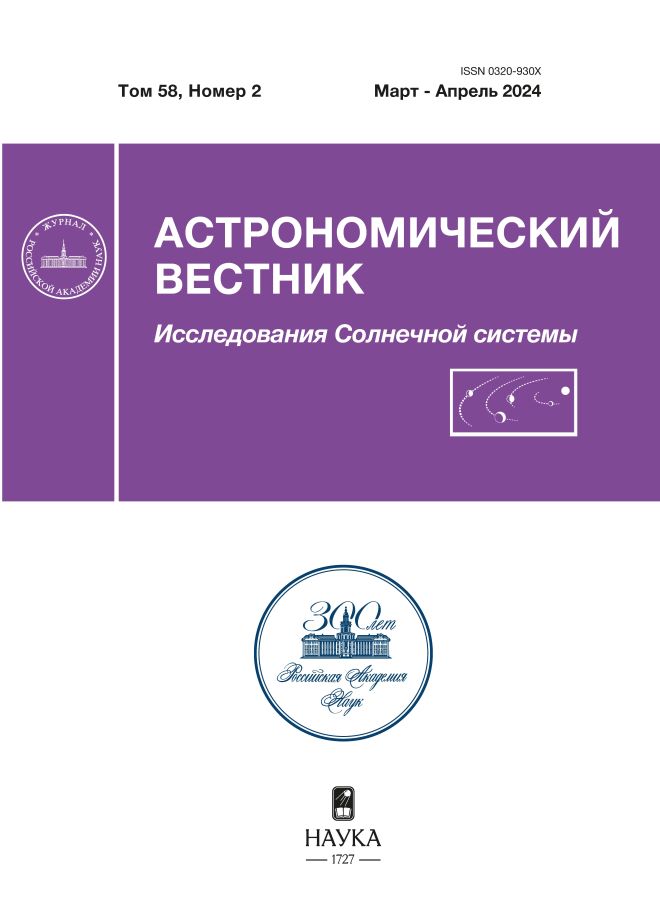Одномерная модель вертикального переноса химических составляющих в атмосфере Марса вплоть до высот термосферы
- Autores: Киливник Е.О.1,2, Петросян А.С.1,2, Федорова А.А.1, Кораблев О.И.1,2
-
Afiliações:
- Институт космических исследований РАН
- Московский физико-технический институт (национальный исследовательский университет)
- Edição: Volume 58, Nº 2 (2024)
- Páginas: 188-197
- Seção: Articles
- URL: https://ter-arkhiv.ru/0320-930X/article/view/648524
- DOI: https://doi.org/10.31857/S0320930X24020049
- EDN: https://elibrary.ru/NUKQVU
- ID: 648524
Citar
Texto integral
Resumo
Работа посвящена исследованию переноса химических составляющих атмосферы Марса. Была поставлена задача исследования турбулентной диффузии химических компонент атмосферы Марса. Для достижения этой цели в приближении диффузии малой составляющей было составлено уравнение непрерывности, а также соответствующая разностная схема. Были поставлены граничные условия в соответствии с известными на данный момент экспериментальными и теоретическими данными, а также получены необходимые профили температуры и давления. Для моделирования были выбраны две модели турбулентной диффузии, которые в дальнейшем использовались при расчетах. Моделирование выполнялось с использованием модернизированного метода Ньютона. Модели показали существенные различия в распределении малых составляющих атмосферы, в частности, водородсодержащих молекул, что указывает на важность выбора описания коэффициента турбулентной диффузии при построении одномерной фотохимической модели атмосферы.
Palavras-chave
Texto integral
Sobre autores
Е. Киливник
Институт космических исследований РАН; Московский физико-технический институт (национальный исследовательский университет)
Autor responsável pela correspondência
Email: Kilivnik.e@phystech.edu
Rússia, Москва; Москва
А. Петросян
Институт космических исследований РАН; Московский физико-технический институт (национальный исследовательский университет)
Email: Kilivnik.e@phystech.edu
Rússia, Москва; Москва
А. Федорова
Институт космических исследований РАН
Email: Kilivnik.e@phystech.edu
Rússia, Москва
О. Кораблев
Институт космических исследований РАН; Московский физико-технический институт (национальный исследовательский университет)
Email: Kilivnik.e@phystech.edu
Rússia, Москва; Москва
Bibliografia
- Изаков М.Н. Структура и динамика верхних атмосфер Венеры и Марса // Успехи физ. наук. 1976. Т. 119. № 2. С. 295–342.
- Краснопольский В.А. Фотохимия атмосфер Марса и Венеры. М.: Наука, 1982. 293 с.
- Куликов Ю.Н., Рыхлецкий М.В. Моделирование вертикального распределения воды в атмосфере Марса // Астрон. вестн. 1983. Т. 17. № 3. С. 144–152. (Kulikov Iu N., Rykhletskii M.V. Modeling of the vertical distribution of water in the atmosphere of Mars //Sol. Syst. Res. 1984. V. 17. № 3. Р. 112–118).
- Куликов Ю.Н. Моделирование химического состава атмосферы Марса. Предварительные результаты сравнения высотного профиля атомарного кислорода с данными измерений спектрометра SPICAM // Тр. Кольского научн. центра РАН. Гелиогеофизика. 2018. Вып. 4. № 5 (9). С. 202–216.
- Маров М.Я., Колесниченко А.В. Введение в планетарную аэрономию. М.: Наука, 1987. 457 с.
- Микрин Е.А., Михайлов М.В., Рожков С.Н., Семенов А.С., Краснопольский И.А., Почукаев В.Н., Марков Ю.Г., Перепелкин В.В. Высокоточный прогноз орбит космических аппаратов, анализ влияния различных возмущающих факторов на движение низкоорбитальных и высокоорбитальных КА // XXI Санкт-Петербургская международная конференция по интегрированным навигационным системам. 2014. С. 77–88.
- Хайрер Э., Ваннер Г. Решение обыкновенных дифференциальных уравнений (анонс) // Математич. моделир. 1999. Т. 11. № 8. С. 127.
- Bougher S., Jakosky B., Halekas J., Grebowsky J., Luhmann J., Mahaffy P., Connerney J., Eparvier F., Ergun R., Larson D., and 74 co-authors. Early MAVEN Deep Dip campaign reveals thermosphere and ionosphere variability // Science. 2015. V. 350. № 6261. id. aad0459.
- Bougher S., Roeten K., Olsen K., Mahaffy P., Benna M., Elrod M., Jain S., Schneider N.M., Deighan J., Thiemann E., and 3 co-authors. The structure and variability of Mars dayside thermosphere from MAVEN NGIMS and IUVS measurements: Seasonal and solar activity trends in scale heights and temperatures // J. Geophys. Res.: Space Physics. 2017. V. 122. № 1. P. 1296–1313.
- Chaffin M.S., Deighan J., Schneider N.M., Stewart A.I.F. Elevated atmospheric escape of atomic hydrogen from Mars induced by high-altitude water // Nature geosci. 2017. V. 10. № 3. P. 174–178.
- Courtney W.G. Kinetics of condensation of water vapor // J. Chem. Phys. 1962. V. 36. № 8. P. 2018–2025.
- Fedorova A.A., Montmessin F., Rodin A.V., Korablev O.I., Määttänen A., Maltagliati L., Bertaux J.L. Evidence for a bimodal size distribution for the suspended aerosol particles on Mars // Icarus. 2014. V. 231. P. 239–260.
- Hirschfelder J.O., Curtiss C.F., Bird R.B. The molecular theory of gases and liquids. John Wiley & Sons, Hoboken, NJ: 1964. 1283 p.
- Hunten D.M. Aeronomy of the lower atmosphere of Mars // Rev. Geophys. 1974. V. 12. № 3. P. 529–535.
- Lindzen R.S. Turbulence and stress owing to gravity wave and tidal breakdown // J. Geophys. Res.: Oceans. 1981. V. 86. № C10. P. 9707–9714.
- Shaposhnikov D.S., Rodin A.V., Medvedev A.S., Fedorova A.A., Kuroda T., Hartogh P. Modeling the hydrological cycle in the atmosphere of Mars: Influence of a bimodal size distribution of aerosol nucleation particles // J. Geophys. Res.: Planets. 2018. V. 123. № 2. P. 508–526.
- Shimazaki T., Shimizu M. The seasonal variation of ozone density in the Martian atmosphere // J. Geophys. Res.: Space Phys. 1979. V. 84. № A4. P. 1269–1276.
- Uddin A.F., Numata K., Shimasaki J., Shigeishi M., Ohtsu M. Mechanisms of crack propagation due to corrosion of reinforcement in concrete by AE-SiGMA and BEM // Construction and Building Materials. 2004. V. 18. № 3. P. 181–188.
Arquivos suplementares















